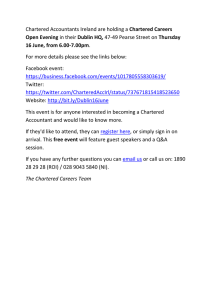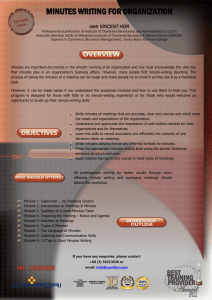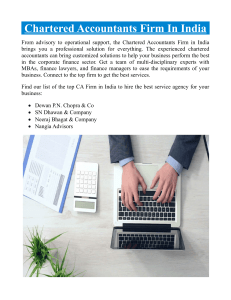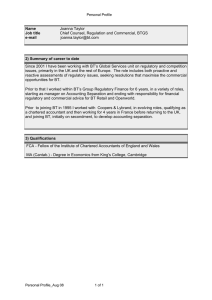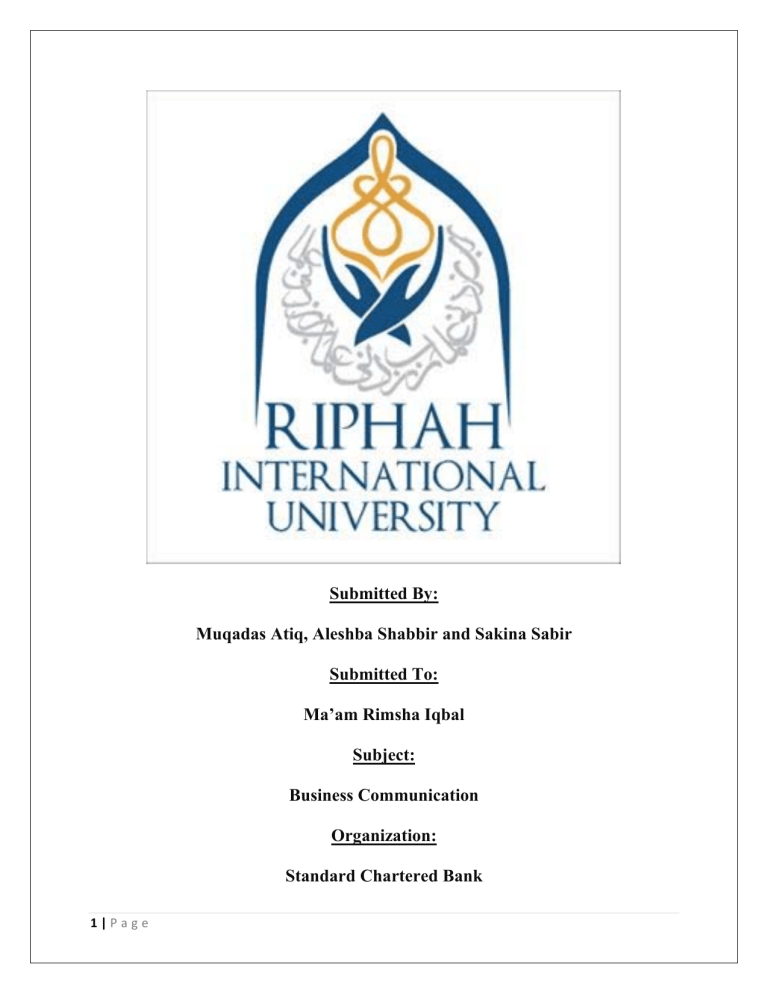
Submitted By: Muqadas Atiq, Aleshba Shabbir and Sakina Sabir Submitted To: Ma’am Rimsha Iqbal Subject: Business Communication Organization: Standard Chartered Bank 1|Page Table Of Contents Acknowledgement ......................................................................................................................... 3 Executive Summary ...................................................................................................................... 4 Introduction ................................................................................................................................... 5 Literature Review ......................................................................................................................... 6 Methodology .................................................................................................................................. 7 Discussion....................................................................................................................................... 7 Communications channel: ........................................................................................................ 7 Internal communication: ....................................................................................................... 8 External communication:....................................................................................................... 8 Means of communication: ........................................................................................................ 8 Reports..................................................................................................................................... 9 Letters:..................................................................................................................................... 9 Electronic mail: .................................................................................................................... 10 Group meetings:.................................................................................................................... 10 Telephone:............................................................................................................................. 11 Communication Barriers:....................................................................................................... 11 Perception ............................................................................................................................. 11 Linguistic difference ............................................................................................................. 11 Time pressure: ...................................................................................................................... 11 Complex organizational structure........................................................................................ 11 Conclusion and recommendations............................................................................................. 12 References .................................................................................................................................... 13 2|Page Acknowledgement We want to express gratitude toward ALLAH Almighty, who has provided us with knowledge, Patience, Courage and most importantly who empowered us to finish my undertaking. By the grace of Almighty Allah, we were able to bring out this report in final shape. We owe a great debt to my respected teacher. In this venture I have taken much direction from my folks and educators. Through the assistance of these individuals my fantasy works out as expected. I want to say thanks to our teacher Ma’am Rimsha Iqbal, who taught us immensely great. We would also like to thank our team members and their immense and relentless support and motivation to complete the report in due time. We perceive this opportunity as a big milestone. We will strive to use the gained skills and knowledge in the best way possible. We will continue to work hard, in order to attain desired course objectives. 3|Page Executive Summary This report is made on the analysis of the communication process of Standard Chartered Bank. It is one of the most reputable bank of Pakistan. The Bank serves both Retail and Corporate and Institutional Banking customers. The analysis was based on the types, forms, means and barriers in the communication. We gathered all the relevant information and prepared this detailed report. After the detailed analysis we came to know that there are two types of communication channels: internal and external communication. Internal communication at Standard Chartered Bank is equally addressed in all three direction i.e. upward, downward and horizontal. Standard Chartered Bank has a very elaborate external communication system which has built over the years of its profitable operations. The medium used to send the information and sources are closely monitored. Then the means of communication which are reports, letters, electronic mail, group meetings etc. We also noticed some barriers which were affecting the communication process which were perception; it refers to how an individual interpret the information send to him, language difference; whereby some words used may have a different meaning from what it was intended during interpretation, time pressure; to achieve a certain set target within a given period tends to either shorten the message and complex organizational structure which is that there are many management levels that make it hard for the employees to pass the information to one to another. After addressing these barriers we also suggested some recommendations which we think would be beneficial for the bank and it would help them to ace. 4|Page Introduction Standard Chartered Bank (Pakistan) Ltd. is one of the oldest and largest international bank in Pakistan. 2013 marked Standard Chartered’s 150th anniversary in Pakistan. The Bank, which started as the Chartered Bank opened its first office in Karachi in March 1863. The Banks serves both Retail and Corporate and Institutional Banking customers. Retail Banking provides credit cards, personal loans, mortgages, deposit taking and wealth management services to individuals. Corporate and Institutional Banking provides clients with services in trade finance, transactional banking, lending, securities services, foreign exchange, debt capital markets and corporate finance. It also offers a complete suite of Islamic banking solutions under its Standard Chartered Saadiq brand. They’re committed to promoting social and economic development in markets through core business of banking. They focus on three priorities: contributing to sustainable economic growth, being a responsible company and investing in communities. The people and businesses they serve are the engines of trade and innovation, and central to the transition to a fair, sustainable future. They’re in a unique position to support the massive shift of capital towards sustainable finance, which has become a priority for investors, companies and individuals alike. They’re determined to develop significant sustainable finance revenues to grow business, and to integrate environmental and social considerations into all our decision-making. They have created an inclusive environment that embraces different perspectives, skills, experience, and ways of working and leadership styles and want people to innovate together, generate new ideas, solve problems, continuously improve and, every so often, create a step change With 85,000 employees and a presence in 59 markets, their network serves customers in close to 150 markets worldwide. They're listed on the London and Hong Kong Stock Exchanges. The Bank employs over 2,800 people in Pakistan and has a network of 40 branches in 10 cities. 5|Page Literature Review Shared Identity Is Key to Effective Communication: Greenaway, Wright Et al. 2014 stated that the capability to communicate with others is one of the most important mortal social functions.This exploration examined the part that participated social identity plays in communication effectiveness using a minimum group paradigm. In two trials, actors constructed a model using instructions that were said to be created by an in-group or an outgroup member. Actors made models of objectively better quality when working from dispatches presumably created by an in-group member. Still, this effect was downgraded when actors were made apprehensive of a participated superordinate identity that included both groups. These findings point to the significance of participated social identity for effective communication and give new perceptivity into the social psychology of communication. Elements of Effective Communication: Akilandeswar, Kumar Et al.2015 stated that Effective communication isn't just a business skill- it is a life skill and the most important source of particular power at work, family and social situations. If the communication reaches the receiver in a distorted form or ever fails to produce meaning or understanding, the person should realize that his/her communication has been affected by walls. So we can say that communication becomes successful only if the receiver understands what the sender is trying to convey. The feedback entered by the sender from the receiver allows the sender to determine how the communication was interpreted and, if necessary. Effective Communication in a Diverse Workplace: Rana 2013 stated that in todays’ globalization, work has come different as people from different societies, persuasions and backgrounds have come together. They bring with them, different chops, knowledge and expertise. Everyone in business moment needs to more understand other societies, as well as other age groups, gender groups, and life groups. All this can be only if there's an effective communication among all the workers, from top to bottom. This paper explains how important is it to have a different pool, what difficulties could come in the way of effective communication in similar different workplaces and how to overcome these difficulties in an effective manner. 6|Page Methodology We chose standard chartered bank because it is one of the oldest and largest international bank in Pakistan. It is also the first international bank to be awarded Islamic banking license and the first to open an Islamic banking branch. This report is made on the basis of interviewing the manager of Standard chartered bank Usman Malik, we had a vast conversation with him about the communication process, he explained us in detail and for the barriers we did some internet research and read some articles about the bank. Discussion Communications channel: Standard Chartered Bank has a relatively formal organizational structure, but great emphasis has been laid on teamwork during the past two to three years. This emphasis on teamwork has led to decentralization of communication and creation of an effective and efficient communication channels. “Standard Chartered Bank has the competitive advantage against other banks because it has one of the most comprehensive communication network”, says Mirza Husnain Ali Baig an officer of the Human Resource Division of the Bank. Standard Chartered Bank has invested a great deal on automation and almost seventy percent of their 430 employees are proficient in computers. Their electronic mail facility provides them with a very important channel for communication which does not require much documentation. As a lot of documentation is sometimes required, the bank also relies heavily on periodic reports and letters which are usually written on the bank’s letterhead. Standard Chartered Bank’s involvement in many business activities has made it imperative for them to develop a good and understandable communication network, which not only motivates the employees but also results in total customer satisfaction.“Our communication network brings us the business and saves the company from any legal problem,” remarked Inshan Ali Nawaz- an Assistant Manager at the Trade Services, at one point in our discussion. The company undertakes training and development programs inside and outside the organization for the development of communication skills of its employees. The company also has some set of rules for communication, like all external communication to clientele should be initialed by a senior authority along with the responsible person. They also have a legal advisor who reviews all the legal documents before transmitting. Standard Chartered Bank realizes that a vital means of attending successfully to the matters of the bank concerns with providing high quality service to 7|Page customers, and this is through effective internal communication- downward, upward and horizontal. The formal communication channel comprises of either of the two major channels mentioned below: Internal communication External communication Internal communication: Internal communication at Standard Chartered Bank is equally addressed in all three direction i.e. upward, downward and horizontal. Equal emphasis is given do these three directions and they have even appointed a communication manager, although such designation still does not formally exist. This service function is headed by Ms. Tania Saeed. She is trying to streamline the whole communication network of the bank so that unnecessary and bulging paperwork is pruned off and wasted efforts and energies in such communication is kept to a minimum. The department will start formally functioning in the near future. External communication: External communication with stakeholders outside the bank can have far reaching effect on its reputation and ultimate success. The right letter, proposal report, telephone call or personal conversation can win back a disgruntled customer, create a desire for the bank’s services, and help negotiate a profitable contract, encourage collections, motivate performance and in general, help the bank to create a goodwill which is crucial in these days of cut-throat competition. Standard Chartered Bank has a very elaborate external communication system which has built over the years of its profitable operations. The medium used to send the information and sources are closely monitored. Although the external communication at Standard Chartered Bank does not follow the ‘you attitude’ in the true sense of the word as followed by banks in the west, but it also does not follow the impersonal style of communication in the conventional sense. As Mr. Inshan Ali Nawaz puts it, “‘You’ attitude is sometimes considered offensive in our culture. After all we have to keep in line with the prevailing culture in Pakistan, and not blindly follow the western practices.” Means of communication: Reports. Letters. 8|Page Electronic Mail. Group meeting. Telephone. Faxes. Reports: Reports for the purpose of upward communication are made periodically by the heads of each of the nine line heads and by the lower management to the heads. The number of reports made differs from department to department depending on the nature of the work being done. For example, an internal report from the Treasury department is technical and analytical, whereas a report from the Human Resource department is very descriptive and informational. The Treasury department generally turns out a greater number of reports due to their urgent needs, whereas the Human Resource department receives monthly MIS’s (Management Information Systems). Periodic reports for upward communication are generally formal and follow a preset format. It gives the next link in the hierarchical chain a comprehensive view without wastage of their precious time.We had asked for a sample of their report, but owing to the confidentiality of the material, our request was declined. Generally, the reports made by most of the departments are very specific, brief and tackle a recurring phenomenon of the bank, like the current prudential regulations of the State Bank of Pakistan, the increase of credit limit of certain clients or the performance of the Treasury department over a period of time. Letters: Documentation is sometimes very essential and because of this a lot of upward communication at Standard Chartered Bank is done by way of writing a letter, normally on either a letterhead or on a blank paper. The letterheads are preprinted with the name of the department and its head.A continuation sheet is used if the letter exceeds the letterhead. The continuation sheet only bears the logo of the bank. In order to save time and supplies, the manager receiving the letter comments or remarks on the original letter and returns the letter back after acknowledgment. The manager does not use a separate letterhead for replies for internal communication. After acknowledgment, the manager may also forward the letter to another horizontal department head. In case the letter is in reply of a query or a request from the CEP, the department head would use a new letterhead for replies. Intra-department communication which does not require a letterhead is written on a blank 9|Page page. Standard Chartered Bank emphasizes that all intra-department communication which does not require documentation should be fully destroyed before being discarded. Electronic mail: E-mail is being extensively used and it is being increasingly recognized as an efficient upward communication channel at Standard Chartered Bank. Electronic mail is used for communication that does not require proper documentation. For upward internal communication, electronic mail is used when a senior manager requires and requests for databases on the current bank position. These computer files are generally complex and technical in nature so that any other oral or written channel of communication would be unsuitable for transmittal of such material. The collapse of the Mehran Bank and stricter prudential regulations from the State Bank of Pakistan are some of the impediments which have hindered the full capitalization on the efficiency and effectiveness of electronic mail. Group meetings: Regular meetings are held in each department and also at the top managerial level which is normally attended by department heads. These meetings discuss the general goals achieved and the targets for the future. Intra-department meetings try to follow the participative management technique which allows the members of a department to participate actively in the meetings and give their suggestions and feedback. Such communications harnesses a sense of prestige for each employee when they are made a part of the decision making process and also enhances their loyalty for the bank. A general meeting is held on a quarterly basis, which is attended by the heads of the branches of the bank throughout Pakistan- these meeting facilitate the coordination among the different branches. Such high level meetings are usually held in the Conference Rooms or Board Rooms of a local hotel. The overall strategy of the bank in this competitive environment is very important for its survival. The importance of implementation of such a strategy is further highlighted by this fact. Therefore, it is imperative for Standard Chartered Bank to review the performance of the bank as against the strategy it had chalked out initially for that period. These group meetings achieve the task of escalating the feedback right from the lower level to the top management. For the last two years, Standard Chartered Bank has realized the synergy of teams. That is why team meetings, especially in Trade Services, provide a healthy ground for problemsolving and brain-storming. 10 | P a g e Telephone: Telephone is most commonly used in the Treasury department as well as in other departments, where most of the external and well as internal communication is carried over the telephone. For example, instructions are laid down through this channel of communication to the different dealers in the Treasury department. Normally, the head of the Treasury department keeps the Chief Executive of Pakistan (CEP) informed daily over the phone about the position of the department. Standard Chartered Bank has a switchboard operator with extensions for each department and subdepartments. Communication Barriers: There are few barriers which are faced by the standard chartered bank employees while communicating. Perception: perception refers to how an individual interpret the information send to him, he or she may view the information send to him as of more or less significant to him or her and thus he may give a positive or negative response to the message. Linguistic difference: It is a major cause of communication breakdown whereby some words used may have a different meaning from what it was intended during interpretation by the recipient. This means that the communication will not have the meaning if the person intended to receive the message cannot be able to make any sensible meaning from it. Time pressure: It is another barrier of communication, to achieve a certain set target within a given period tends to either shorten the message or give partial messages which are not complete and lack the essential details. Complex organizational structure: It is another barrier that leads to an effective communication across the organization, where the hierarchy has a large number of management levels and becomes difficult to pass information from one level to the next. 11 | P a g e Conclusion and recommendations We did a whole analysis of communication process and after getting to know about the detailed process I’ve concluded that this system has few faults on which they should do proper working we came to know about the few barriers which were affecting the process and there are few recommendations which would help them to get better with it. 1. The employees should have authentic communication which should be filled with empathy and positive attitude. 2. Be wary of requiring only one specific language to be spoken at all times. In some circumstances, it could be argued that all employees need to speak a common language for safety reasons; but, employers should be careful not to overstate the requirement by completely banning all other languages from the worksite. 3. Employees should work in small stress rather than taking time stress. 4. Evaluate existing workflow systems and processes, Aim for user-friendly processes, Encourage team members to offer insights into complexity reduction and build a culture of simplified processes. 12 | P a g e References https://www.bartleby.com/essay/Communication-Structure-of-Standard-Chartered-BankPKZLSJSX7KUEY#:~:text=The%20key%20parts%20of%20the,%3A%20upward%2C%20dow nward%2C%20lateral. https://papers.ssrn.com/sol3/papers.cfm?abstract_id=2225761 https://www.researchgate.net/profile/PratyushTripathi/publication/257987416_IRC%27S_IJRSMS_ISSN_23208236_Vol_1_Issue_No2_April__June_2013_wwwircjournalsorg/links/00b495268e296cedf0000000/IRCS-IJRSMS-ISSN-23208236-Vol-1-Issue-No2-April-June-2013-wwwircjournalsorg.pdf#page=86 https://www.tandfonline.com/doi/abs/10.1080/13561820802338579 https://www.sc.com/pk/ 13 | P a g e
